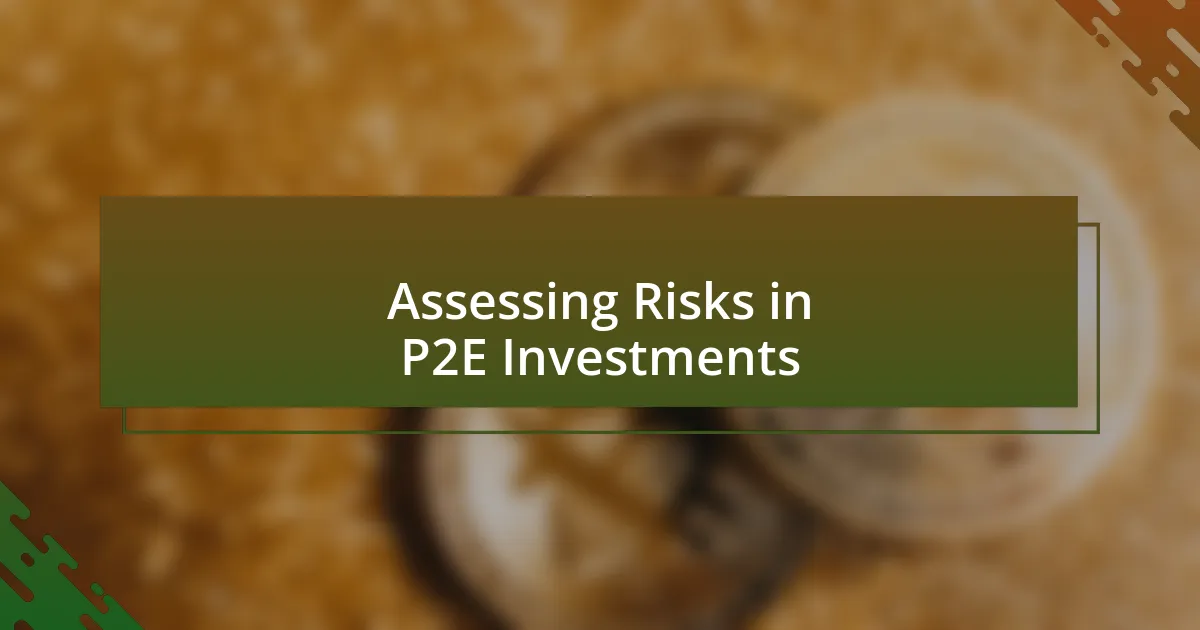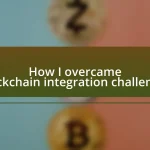Key takeaways:
- P2E market allows players to earn real-world assets through gaming, supported by blockchain technology.
- Key market trends include player engagement, technology innovations, regulatory changes, and e-commerce integrations.
- Successful P2E games focus on community engagement, diverse rewards systems, and a balance of visual appeal and gameplay quality.
- Strategies for risk management in P2E investments include diversification and staying informed about regulatory developments and community sentiments.

Understanding P2E Market Basics
The play-to-earn (P2E) market combines gaming and economic incentive, allowing players to earn real-world assets through in-game activities. I remember the first time I earned a digital token while playing, and the thrill was surreal; it felt as if I had unlocked a treasure chest. This unique setup is why many are drawn to P2E games, but it raises the question: can gaming really be a viable income source?
Understanding P2E also means grasping the blockchain technology that powers it. When I first delved into blockchain, I was fascinated by its potential to create ownership of digital assets. This shift from traditional gaming models underscores how players are now empowered to not just participate but also own a piece of the game world.
As I navigated the P2E landscape, I quickly realized that market trends fluctuate just like any other industry. I often find myself asking how changes in player engagement and technological advancements will impact earnings. It’s a constant evolution, and staying informed is crucial for anyone wanting to thrive in this space.

Recognizing Key Market Trends
Recognizing key market trends in the P2E space requires a vigilant eye for emerging patterns. One memorable moment for me was when I observed a surge in interest around mobile P2E games. The excitement among players was palpable, and it became clear that accessibility was driving engagement. As I engaged with different communities, I noticed how discussions around monetization strategies were evolving, indicating a shift in player priorities.
To effectively navigate these trends, consider these key indicators:
- Player Engagement: Look for spikes in active users and how they interact within games.
- Technological Innovations: Pay attention to new features, especially those enhancing user experience.
- Regulatory Changes: Keep an eye on legislation that could impact the operation of P2E games.
- Market Adaptability: Assess how games morph in response to player feedback and market demands.
- E-commerce Integration: Notice any partnerships with platforms that facilitate asset exchanges outside the gaming world.
As my understanding deepened, I found myself adapting my strategies in real-time, often feeling that rush of excitement every time I spotted a trend before it became mainstream. It’s this sense of anticipation that fuels my ongoing exploration into the P2E market.

Analyzing Successful P2E Games
Analyzing successful P2E games requires a thoughtful examination of what sets them apart. From my experience, games that cultivate community engagement tend to thrive, as I noticed with one particular title that regularly hosted community events. This not only kept players invested but also enhanced their loyalty, further solidifying the game’s place in the market.
When I look back, I find that the mechanics of earning within these games also play a crucial role. I recall a conversation where players shared their excitement about the diverse rewards systems in a popular game, likening it to a treasure hunt. The thrill of unlocking new achievements kept them returning, emphasizing how crucial reward variety is for player retention.
Finally, it’s interesting to observe how graphical quality and gameplay experience impact a game’s success. I’ve often seen that the visual appeal of a game can draw players in at first glance, yet it’s the fluid gameplay that keeps them engaged. Reflecting on the titles I’ve played, it becomes clear that balancing aesthetics with user experience is vital for long-term success in the P2E landscape.
| Game Title | Community Engagement |
|---|---|
| Game A | Frequent community events |
| Game B | Interactive forums and feedback systems |

Strategies for Engaging with Communities
Engaging with communities in the P2E space can truly transform a game’s atmosphere. I remember joining a Discord server for a game where developers actively participated in discussions. This direct interaction made players feel valued and heard, fostering a sense of belonging that kept many of us engaged even during quiet game updates. Wouldn’t you agree that knowing someone is listening can change your perspective on a game?
Another successful strategy I’ve observed is organizing virtual tournaments. During one event, I participated in a competitive match where the excitement and camaraderie among players created an electrifying environment. The thrill of teamwork and competition not only deepened my connection to the game but also to fellow players, reinforcing why community-driven events are essential.
Lastly, feedback loops with the community can’t be overlooked. I recall one instance where a game’s developers implemented changes based on our suggestions. The decision to integrate player feedback not only improved gameplay but also helped build trust and excitement among us. It’s fascinating to see how inclusive practices can lead to a vibrant and motivated player base, isn’t it?

Assessing Risks in P2E Investments
Assessing risks in P2E investments is crucial, as the volatility of this market can often catch new investors off guard. I recall investing in a game that initially showed great promise but soon faced unforeseen regulatory challenges. That experience taught me how important it is to stay updated on legal developments impacting the P2E landscape, something that can drastically affect asset values.
Moreover, the nature of player engagement can also pose risks. I invested in a game that seemed to have built a solid community, yet the actual player retention was surprisingly low. This led me to wonder: how do we gauge genuine interest versus short-lived hype? Understanding metrics like daily active users and community sentiment can provide deeper insights into a project’s sustainability.
Lastly, diversifying investments across multiple games can mitigate risks significantly. When I first entered the market, I put all my eggs in one basket, which left me vulnerable when that particular game underperformed. By allocating resources across various P2E titles, I’ve found a more balanced approach that shields me from drastic declines in any one project. Wouldn’t it be wise to spread out our investments to safeguard against market unpredictability?

Tools for Tracking P2E Trends
When it comes to tracking trends in the P2E market, several tools have become essential to my strategy. One that stands out is DappRadar. It provides invaluable data on daily active users and transaction volumes across various games. I remember the first time I used it to analyze a new game; seeing the user metrics in real-time helped me avoid investing in a project that was all talk and no action.
Another fantastic resource I’ve utilized is Discord. Many P2E games maintain active communities where players share their experiences and insights. Engaging directly in these channels often gives me a feel for upcoming trends that data alone can’t capture. I once stumbled upon a discussion about a game that was set to launch its next phase, and being part of that conversation alerted me to a potential investment opportunity before it gained traction.
Lastly, Twitter has also emerged as a powerful tool for real-time updates and networking. Following industry influencers and game developers has allowed me to gain insights into upcoming projects and potential risks quickly. For instance, I remember reading a developer’s tweet about a significant update, which prompted me to reassess my positions in related games. Isn’t it fascinating how dynamic the P2E landscape is, and how a single tweet can impact investment decisions?

Formulating a Personal P2E Strategy
Formulating a personal strategy in the P2E market requires a thoughtful approach tailored to individual preferences and risk tolerance. I’ve always believed that understanding your gaming style plays a crucial role in this process. For instance, I tend to gravitate toward games that balance fun with earning potential, so I often prioritize projects that resonate with my gaming habits rather than just following the market hype.
When crafting my strategy, I focus on diversification. I remember a time when I heavily invested in one game that seemed promising but quickly lost its player base. It was a hard lesson learned. Now, I allocate my resources across various games to mitigate risk and capitalize on multiple opportunities. This balancing act takes careful monitoring, but the rewards can be significant when you have a variety of investments at different stages of their development.
Moreover, I frequently reassess my strategy based on emerging trends and personal experiences within the community. Engaging with other players has led me to discover unique projects that I wouldn’t have found through traditional research alone. How often do we overlook the power of community insights? For me, tapping into player conversations has opened doors to investments I never imagined would yield such returns. Remember, your personal strategy isn’t static; it should evolve just as quickly as the market itself.















